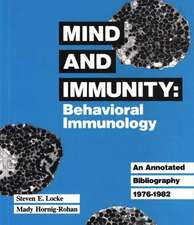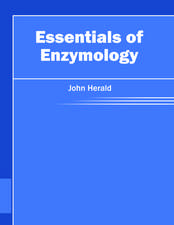The Immunoassay Handbook: Theory and Applications of Ligand Binding, ELISA and Related Techniques
Editat de David Wilden Limba Engleză Hardback – 31 ian 2013
Highly illustrated and clearly written, this award-winning reference work provides an excellent guide to this fast-growing field. Revised and extensively updated, with over 30% new material and 77 chapters, it reveals the underlying common principles and simplifies an abundance of innovation.
The Immunoassay Handbook reviews a wide range of topics, now including lateral flow, microsphere multiplex assays, immunohistochemistry, practical ELISA development, assay interferences, pharmaceutical applications, qualitative immunoassays, antibody detection and lab-on-a-chip.
This handbook is a must-read for all who use immunoassay as a tool, including clinicians, clinical and veterinary chemists, biochemists, food technologists, environmental scientists, and students and researchers in medicine, immunology and proteomics. It is an essential reference for the immunoassay industry.
Provides an excellent revised guide to this commercially highly successful technology in diagnostics and research, from consumer home pregnancy kits to AIDS testing.www.immunoassayhandbook.com is a great resource that we put a lot of effort into. The content is designed to encourage purchases of single chapters or the entire book.
David Wild is a healthcare industry veteran, with experience in biotechnology, pharmaceuticals, medical devices and immunodiagnostics, which remains his passion. He worked for Amersham, Eastman-Kodak, Johnson & Johnson, and Bristol-Myers Squibb, and consulted for diagnostics and biotechnology companies. He led research and development programs, design and construction of chemical and biotechnology plants, and integration of acquired companies. Director-level positions included Research and Development, Design Engineering, Operations and Strategy, for billion dollar businesses. He retired from full-time work in 2012 to focus on his role as Editor of The Immunoassay Handbook, and advises on product development, manufacturing and marketing.
- Provides a unique mix of theory, practical advice and applications, with numerous examples
- Offers explanations of technologies under development and practical insider tips that are sometimes omitted from scientific papers
- Includes a comprehensive troubleshooting guide, useful for solving problems and improving assay performancee
- Provides valuable chapter updates, now available on www.immunoassayhandbook.com
Preț: 982.86 lei
Preț vechi: 1080.07 lei
-9% Nou
Puncte Express: 1474
Preț estimativ în valută:
188.10€ • 195.65$ • 155.28£
188.10€ • 195.65$ • 155.28£
Carte tipărită la comandă
Livrare economică 07-21 aprilie
Livrare express 08-14 martie pentru 469.99 lei
Preluare comenzi: 021 569.72.76
Specificații
ISBN-13: 9780080970370
ISBN-10: 0080970370
Pagini: 1036
Dimensiuni: 216 x 276 x 46 mm
Greutate: 2.79 kg
Ediția:Revised
Editura: ELSEVIER SCIENCE
ISBN-10: 0080970370
Pagini: 1036
Dimensiuni: 216 x 276 x 46 mm
Greutate: 2.79 kg
Ediția:Revised
Editura: ELSEVIER SCIENCE
Public țintă
Laboratory researchers and academics who use immunoassay as a tool including pathologists, clinical and veterinary chemists, biochemists, students and researchers in immunology, biochemistry and medicine.Cuprins
Part 1 IMMUNOASSAY FUNDAMENTALS
1.1 How to use this book
1.2 Immunoassays for beginners
1.3 Immunoassay performance measures
Part 2 IMMUNOASSAY CONFIGURATIONS
2.1 Competitive and immunometric assays (including ELISA)
2.2 Non-competitive immunoassays for small molecules
2.3 Homogenous immunoassays
2.4 Lateral flow immunoassay devices
2.5 Ambient analyte immunoassay
2.6 Free analyte immunoassay
2.7 Qualitative immunoassays
2.8 Immunoassays for the detection or quantification of antibodies
2.9 Microsphere-based Multiplex Immunoassays: Development and Applications using Luminex xMAP Technology
2.10 Lab on a chip
2.11 Immunological Biosensors
2.12 SPR
2.13 Single Molecule Array
Part 3 IMMUNOASSAY COMPONENTS
3.1 Antibodies
3.2 Signal generation systems
3.3 Solid-phase and other separation systems
3.4 Conjugation methods
3.5 Standardisation and calibration
3.6 Calibration curve-fitting
Part 4 RELATED TECHNIQUES
4.1 Foundations of immunochemistry
4.2 Immunohistochemistry and immunofluorescence
Part 5 IMMUNOASSAY DEVELOPMENT
5.1 Practical guide to ELISA development
5.2 Performance evaluation and validation
5.3 Interferences in immunoassay
5.4 Immunoassay development in industry
Part 6 IMMUNOASSAY IMPLEMENTATION
6.1 Subject preparation, sample collection and handling
6.2 Laboratory quality assurance
6.3 Point-of-care testing
6.4 Choosing an automated immunoassay system
6.5 Troubleshooting guide
Part 7 IMMUNOASSAY PRODUCT TECHNOLOGY
7.1 Introduction to product technology
7.2 Market trends
7.3 Lateral Flow and Consumer Diagnostics
7.4 Clearblue
7.5 TRIAGE
7.6 Stratus CS
7.7 IMx
7.8 AxSYM
7.9 Architect
7.10 Advia CENTAUR
7.11 IMMULITE and IMMULITE 1000
7.12 IMMULITE 2000 and IMMULITE 2000 Xpi
7.13 Eci
7.14 Vitros Clin chem
7.15 Access 2
7.16 Dxl 600 and 800
7.17 Elecsys
7.18 PRISM
7.19 Phadia systems
Part 8 IMMUNOASSAY APPLICATIONS OTHER THAN CLINICAL CHEMISTRY
8.1 Immunoassay applications in veterinary diagnostics
8.2 Immunoassays in the pharmaceutical industry
Part 9 IMMUNOASSAY CLINICAL APPLICATIONS (HUMAN)
9.1 Clinical concepts
9.2 Thyroid
9.3 The adrenal cortex
9.4 Bone metabolism
9.5 Infertility
9.6 In vitro fertilization and embryo transfer
9.7 Hirsutism and virilization in the female
9.8 Pregnancy
9.9 Growth and growth hormone deficiency
9.10 Diabetes mellitus
9.11 Hematology
9.12 Cardiac markers
9.13 Cancer markers
9.14 Allergy
9.15 Autoimmune diseases
9.16 GI Tract
9.17 Hepatitis
9.18 HIV
9.19 Other viral diseases (excl HIV and Hepatitis)
9.20 Other bacterial diseases
9.21 Fungal and parasitic diseases
9.22 Therapeutic drug monitoring
9.23 Drugs of abuse
1.1 How to use this book
1.2 Immunoassays for beginners
1.3 Immunoassay performance measures
Part 2 IMMUNOASSAY CONFIGURATIONS
2.1 Competitive and immunometric assays (including ELISA)
2.2 Non-competitive immunoassays for small molecules
2.3 Homogenous immunoassays
2.4 Lateral flow immunoassay devices
2.5 Ambient analyte immunoassay
2.6 Free analyte immunoassay
2.7 Qualitative immunoassays
2.8 Immunoassays for the detection or quantification of antibodies
2.9 Microsphere-based Multiplex Immunoassays: Development and Applications using Luminex xMAP Technology
2.10 Lab on a chip
2.11 Immunological Biosensors
2.12 SPR
2.13 Single Molecule Array
Part 3 IMMUNOASSAY COMPONENTS
3.1 Antibodies
3.2 Signal generation systems
3.3 Solid-phase and other separation systems
3.4 Conjugation methods
3.5 Standardisation and calibration
3.6 Calibration curve-fitting
Part 4 RELATED TECHNIQUES
4.1 Foundations of immunochemistry
4.2 Immunohistochemistry and immunofluorescence
Part 5 IMMUNOASSAY DEVELOPMENT
5.1 Practical guide to ELISA development
5.2 Performance evaluation and validation
5.3 Interferences in immunoassay
5.4 Immunoassay development in industry
Part 6 IMMUNOASSAY IMPLEMENTATION
6.1 Subject preparation, sample collection and handling
6.2 Laboratory quality assurance
6.3 Point-of-care testing
6.4 Choosing an automated immunoassay system
6.5 Troubleshooting guide
Part 7 IMMUNOASSAY PRODUCT TECHNOLOGY
7.1 Introduction to product technology
7.2 Market trends
7.3 Lateral Flow and Consumer Diagnostics
7.4 Clearblue
7.5 TRIAGE
7.6 Stratus CS
7.7 IMx
7.8 AxSYM
7.9 Architect
7.10 Advia CENTAUR
7.11 IMMULITE and IMMULITE 1000
7.12 IMMULITE 2000 and IMMULITE 2000 Xpi
7.13 Eci
7.14 Vitros Clin chem
7.15 Access 2
7.16 Dxl 600 and 800
7.17 Elecsys
7.18 PRISM
7.19 Phadia systems
Part 8 IMMUNOASSAY APPLICATIONS OTHER THAN CLINICAL CHEMISTRY
8.1 Immunoassay applications in veterinary diagnostics
8.2 Immunoassays in the pharmaceutical industry
Part 9 IMMUNOASSAY CLINICAL APPLICATIONS (HUMAN)
9.1 Clinical concepts
9.2 Thyroid
9.3 The adrenal cortex
9.4 Bone metabolism
9.5 Infertility
9.6 In vitro fertilization and embryo transfer
9.7 Hirsutism and virilization in the female
9.8 Pregnancy
9.9 Growth and growth hormone deficiency
9.10 Diabetes mellitus
9.11 Hematology
9.12 Cardiac markers
9.13 Cancer markers
9.14 Allergy
9.15 Autoimmune diseases
9.16 GI Tract
9.17 Hepatitis
9.18 HIV
9.19 Other viral diseases (excl HIV and Hepatitis)
9.20 Other bacterial diseases
9.21 Fungal and parasitic diseases
9.22 Therapeutic drug monitoring
9.23 Drugs of abuse
Recenzii
"The beauty of this book is that it covers the whole field of immunoassay from reagents to method development, interferences and applications…The fourth edition does not disappoint. It is an essential reference manual for staff using immunoassays and to students in the field of laboratory medicine and other science disciplines." --Annals of Clinical Biochemistry, November 2013
"The book starts out very basic with principles of immunoassays (‘immunoassays for beginners’) and builds progressively to discuss immunoassay components, configurations, development, implementation, product technology, applications other than clinical chemistry, and concludes with 23 chapters on clinical applications to human disease…This is the single ‘go-to’ book for any questions regarding immunoassays. If this is an area of interest for you, you must have this edition." --Doody.com, November 2013
"Editors Wild, John, Sheehan, Binder, and He present this handbook on the highly sensitive technique of immunoassay…Equations, figures, and real-world examples are used to clarify mechanisms and analysis. The range of detail makes it appropriate as both a pedagogical resource and a reference for immunology labs." --Reference and Research Book News, October 2013
"...it must be stated that there is much of value in the volume [2nd Ed.]. It is a useful and informative addition to any scientific library." --Robert F. Ritchie, Foundation for Blood Research, Scarborough, USA
"The book starts out very basic with principles of immunoassays (‘immunoassays for beginners’) and builds progressively to discuss immunoassay components, configurations, development, implementation, product technology, applications other than clinical chemistry, and concludes with 23 chapters on clinical applications to human disease…This is the single ‘go-to’ book for any questions regarding immunoassays. If this is an area of interest for you, you must have this edition." --Doody.com, November 2013
"Editors Wild, John, Sheehan, Binder, and He present this handbook on the highly sensitive technique of immunoassay…Equations, figures, and real-world examples are used to clarify mechanisms and analysis. The range of detail makes it appropriate as both a pedagogical resource and a reference for immunology labs." --Reference and Research Book News, October 2013
"...it must be stated that there is much of value in the volume [2nd Ed.]. It is a useful and informative addition to any scientific library." --Robert F. Ritchie, Foundation for Blood Research, Scarborough, USA






















